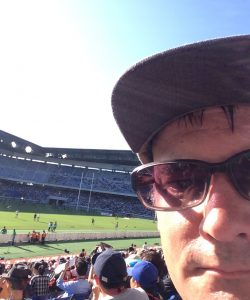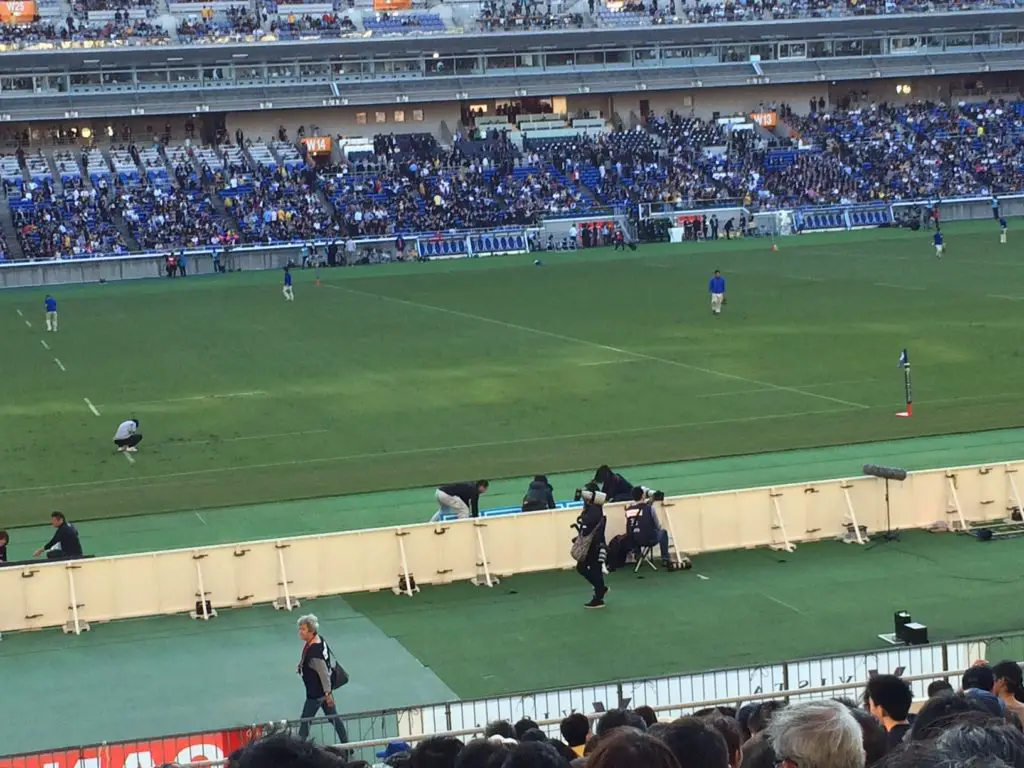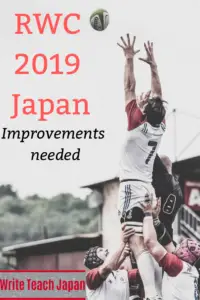New Zealand vs. Australia Rugby in Yokohama 2018
Last weekend (27 October), a few friends and I went to Tokyo for a long weekend and to watch the New Zealand vs. Australia rugby match at Nissan Stadium in Yokohama. Overall the experience was great, but there are a few improvements that could be made before the big tournament kicks-off in September next year.


It’s interesting to think about this game in Yokohama as being a test run for the Rugby World Cup in Japan next year. Especially when, to a large extent, most of Japan sees the Rugby World Cup as a test run for the 2020 Tokyo Olympics.
Rugby at Nissan Stadium Yokohama
Tokyo to Yokohama by Train
Getting to Yokohama by train from Tokyo was easy. We had absolutely no trouble at all. Our hotel was in Ueno, so from Ueno station we took the Keihin-Tōhoku Line to Higashi Kanagawa. We then transferred to the JR Yokohama Line and took that to Shin-Yokohama. Nissan Stadium was about a ten minute walk from there.
Similarly, getting back to Tokyo was fine. I expected perhaps a one hour wait in the station or standing on the platform. Although we walked slowly out of the stadium with the crowd, we would have been in the station for less than twenty minutes. We had to stand for about ten minutes on the train, but the various routes back to Tokyo meant that the train emptied out quite quickly. Of course, that’s a big city’s ability to absorb an event.
Keep in mind that the attendance at this game was 46,143 of a capacity 72,327. The stadium should reach this capacity two or three times in pool play, as well as both semi-finals and the final.
Security Staffing and Delays
Some people complained over twitter that the security and bag checks were understaffed and the lines were too long. In some cases it meant that people missed the start of the game. I’m not sure that I have much sympathy for those people. This was a rugby match to the scale that Japan had never seen before, you have to expect some delays getting people into the stadium. We entered via the East Gate and went through security without any delay at all, the process took about ten seconds per person. We did go through security 90 minutes before kickoff, but when you’re unfamiliar with an area, and you don’t know how ling it will take to get in, that’s what you do.
Security Measures
There were parts of the security measures I found surprising. I don’t think I’d ever been through a metal detector to get into a sports event before. Remember that I’m from New Zealand, and perhaps experiences in the U.S. or U.K. are different. I couldn’t really understand it here in Japan because it’s so difficult to get a gun. Are they looking for knives?
I did a quick search about whether it was common to go through metal detectors to get into Rugby World Cup matches in the past. I had no luck there but I did come across this Japan Times article from a few months ago that may explain it to some extent.
Shinkansen stabbing raises alarm over security ahead of Rugby World Cup and Tokyo Olympics
My dad was a volunteer driver and he went to a lot of games at the 2011 Rugby World Cup in New Zealand. He said he never went through a metal detector for those games.
The Bag Check
The most surprising thing for me was the bag search. It was the end of October, and I was heading to a rugby stadium, so I was ready for the cold. It turned out to be about 24 degrees so my jacket and a hoodie were stuffed into my bag, along with the All Blacks merchandise I’d bought. I opened my bag and put it on the table in front of the security staff. He looked into it, and waved me on. I couldn’t believe it. He didn’t put his hands in the bag, didn’t move any of my clothes, he didn’t even pat down the outside of the bag. It was interesting that my body was then scanned by the handheld metal detectors, but I’d put my bag down (as directed) so I could lift my arms. If something was concealed in my bag it wouldn’t have been picked up. Thus, making the metal detectors useless.
The Nissan Stadium Yokohama Experience
The stadium was well set out. It was easy to get from the concourse to the seating area. The seats seemed a higher quality than the ones I’m used to in New Zealand. The plastic is a bit more robust. A lot better than the flimsy yellow things at Westpac Stadium, Wellington. And there’s a drink holder attached to the back of the chair in front of you, which is a good idea.
Even though there is an athletics track around the field, I didn’t feel like I was too far away from the action. We were in category B seating and pretty much in line with one of the try lines. Yes I had to watch the big screen when a team was camped on the other try line, but that’s no big deal.
Lighting
The biggest issue with watching the game itself was the lighting. For the first half of the game the sun was still shining into the stadium. After the sun went down, not long before half-time, it was the dimmest match of professional sport that I have ever seen. The light went gradually and we didn’t notice it before they went off for the half-time break, but when they came back out it was very noticeable. I wondered what it was like on TV. The clips I saw of the match on Youtube looked pretty dark. Has any body heard any other people mention this? I’d love to hear about it in the comments.
Quality of the Turf
I didn’t initially notice it, but my sister (who was watching on TV) messaged me ten minutes into the game to say that the field was getting pretty “ripped up” for so early in the match. Sure enough, there’d been a scrum reset a few times right in front of us and the grass looked terrible with brown clods all over it.
I sent her this photo at half time. A team of groundsmen out cleaning up the pitch at half time. Honestly, that pitch looks worse than a club game.

I wish I’d paid more attention at the time. The above picture seems to show that the grass is on quite a thin mat of turf.
I can’t understand it because below is a screen-shot I took from nissan-stadium.jp

Leaving the Stadium
We went out of the east side of the stadium at about 5:30pm. It was getting quite gloomy but not yet dark, which was a good thing because we walked out of the brightly lit concourse into a courtyard area which wasn’t lit at all. This will have to be fixed before the World Cup kicks off at this stadium on Saturday 21 September 2019. The All Blacks vs South Africa game kicks off at 6:45 pm.
Entertainment / Dining Around the Stadium
The small area around the Shin Yokohama Station was nice. We had a wander around for an hour or so. We were taking in the atmosphere and looking for somewhere to have lunch. That was a little bit of a problem. We arrived at Shin Yokohama about 11:30 and all of the places that offered alcohol were packed. There were only 3 or 4 of them. We would have liked to have a pub-style lunch ourselves but they were already overflowing. It looked as though they were 90% filled with New Zealanders and Australians. They were having a good time. It did mean that we had to have horrible little sandwiches and iced-tea for lunch from one of those chain cafes that they have everywhere in Japan.
Alcohol
In doing a bit of research for this article I came across a Japan Times interview with a guy who had come over from New Zealand for the game. He said:
“I’m not 100 percent sure the Japanese people and the bar owners are quite used to the drinking culture of the visitors,” he said. “That could be an interesting challenge for them. They’re not used to the consumption.”
It’s an interesting point, and to tell you the truth I don’t think the bar owners are ready. But I’d like to suggest that it would be just as true to put it this way:
Japan is a safe and considerate country and as a result, living in Japan, you enjoy a lot more freedoms around alcohol; like the ability to drink in public and the easy accessibility of alcohol 24 hours a day. I’m not 100% sure the visitors are quite ready for the responsibility of looking after their own level of consumption.
Rugby at Nissan Stadium Yokohama – Overall
I don’t want, or mean, to be nit-picky. These are just the things that occurred to me at the time. Overall, it was a great event and a great day out. I’m really looking forward to how Japan hosts the Rugby World Cup 2019. I hope that it does for rugby in Japan what the 2002 World Cup did for soccer. We’re in the ticket ballot at the moment and holding our breath to get All Blacks vs South Africa tickets. We find out in the next few weeks.
Rugby World Cup 2019 Mascots

Lastly, I saw the Rugby World Cup 2019 mascots for the first time. I hadn’t even considered the possibility of there being mascots for the the World Cup. I’d obviously momentarily forgotten I was in Japan and that there are mascots for everything. They are based on characters from Kabuki, a traditional Japanese style of theatre.
The two mascots are a parent and child duo. The parent Ren (the one with white hair) and the child G (red hair) are supposed to embody the five values of rugby: integrity, passion, solidarity, discipline, and respect.
Thank you so much for reading. Please leave a comment if you agree / disagree / have any more info on anything I’ve said.


